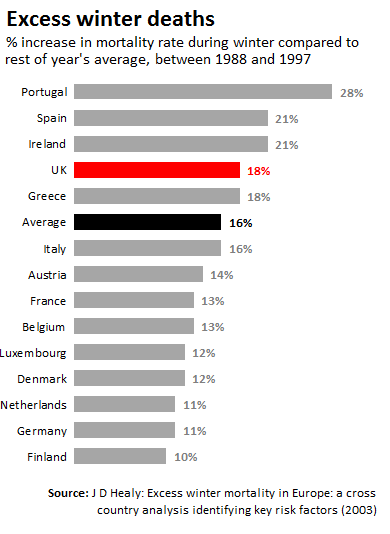31,000 excess deaths last winter: what's to blame?
"Bitter conditions linked to deaths of additional 31,000 people last winter - a rise of almost one third"
Independent, 26 November 2013
"The Office for National Statistics said that fluctuations in "excess" deaths are not correlated with cold winters, but with cold homes."
"... international comparisons are shocking: the UK has the highest excess winter death rate among comparable north European countries. Proportionately, many fewer die in Scandinavia although it's far colder; and fewer in France and Germany, yet we have lower energy prices."
Join 72,953 people who trust us to check the facts
Sign up to get weekly updates on politics, immigration, health and more.
Subscribe to weekly email newsletters from Full Fact for updates on politics, immigration, health and more. Our fact checks are free to read but not to produce, so you will also get occasional emails about fundraising and other ways you can help. You can unsubscribe at any time. For more information about how we use your data see our Privacy Policy.
Polly Toynbee in the Guardian, 29 November 2013
Winter is a dish that's always served cold, whether we like it or not. For some, the apparent consequences can be tragic. Last winter, 31,100 people more people died than the average for the rest of that year. In other words, there were 31,100 excess winter deaths.
It's normal and in-keeping with other European countries for a greater number of people to die in the winter than the summer, but some commentators seemingly haven't agreed on what's to blame.
First, some perspective. Excess deaths are falling over the long-term. Numbers of 60,000 or 70,000 wouldn't have been uncommon in the 1950s and 60s. Now, 31,000 remains one of the lowest counts on record, although represents the latest in a steadily growing trend since the turn of the century.
At the same time, as Polly Toynbee remarked today, the UK's death toll is high when compared to other European countries - at least as far as we can tell from the scant evidence available. The only study we've found that examines excess deaths internationally involved those in 14 European countries in the 1980s and 1990s.
That research - still quoted by the Office for National Statistics today - placed the UK among the countries which saw the largest proportional increase in deaths during the winters compared to the rest-of-year averages.

So is this just a case of bad weather? The graph gives away the first clue that it's not that simple. The countries with the highest 'seasonal variations' in deaths are Portugal and Spain, which hardly have the coldest climates on the list. Meanwhile northern European countries - Finland, Germany and the Netherlands - have comparatively few excess deaths.
In fact the study which unearthed these figures found that higher average winter temperatures were associated with higher average excess deaths: it termed this the "paradox of excess winter mortality".
The explanation for this is put down to differing levels of thermal efficiency. Warmer countries tended to have poorer standards of home insulation. Even looking at more recent figures for 2011, the case is similar: Scandinavian countries have high efficiency, Portugal and Spain less so.
The 'cold home' theory made up a key feature in the paper's conclusion:
"Improving the thermal standards of housing could be an effective preventative intervention in curbing excess deaths. Such a health strategy would also assist in the alleviation of fuel poverty, which, this study shows, is also highest in those countries in southern and western Europe with the poorest energy efficiency."
This is old research, and we're getting more and more energy efficient, but the ONS concurs with it as a possible explanation, and goes on to cite numerous other studies which found that low temperatures are not the lone or even the main cause of excess winter deaths.
Other factors could well play their part as well, but the research certainly suggests there's much more to winter deaths than the cold weather alone.